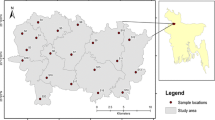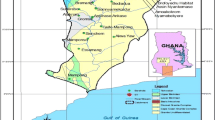Abstract
The dependency of people on groundwater has increased in the past few decades due to tremendous increase in crop production, population and industrialization. Groundwater is the main source of irrigation in Shiwaliks of Punjab. In the present study the samples were collected from predetermined location as was located on satellite image on basis of spectral reflectance. Global positioning system was used to collect samples from specific locations. Principal components analysis (PCA) together with other factor analysis procedures consolidate a large number of observed variables into a smaller number of factors that can be more readily interpreted. In the present study, concentrations of different constituents were correlated based on underlying physical and chemical processes such as dissociation, ion exchange, weathering or carbonate equilibrium reactions. The PCA produced six significant components that explained 78% of the cumulative variance. The concentration of the few trace metals was found to be much higher indicating recharge due to precipitation as main transport mechanism of transport of heavy metals in groundwater which is also confirmed by PCA. Piper and other graphical methods were used to identify geochemical facies of groundwater samples and geochemical processes occurring in study area. The water in the study area has temporary hardness and is mainly of Ca–Mg–HCO3 type.












Similar content being viewed by others
References
American Public Health Association (APHA) (1995) Standard methods for the examination of water and waste water, 19th edn. American Public Health Association, Washington, DC
Ashley RP, Lloyd JW (1978) An example of the use of factor analysis and cluster analysis in ground water chemistry interpretation. J Hydrol 39:355–364
Bhatt CM, Litoria PK, Sharma PK (2008) Geomorphic signatures of active tectonics in Bist Doab Interfluvial Tract of Punjab, NW India. J. Indian Soc. Remote Sens. 36:361–373
Burrough PA, McDonnell RA (1998) Principles of geographical information systems for land resources assessment. Oxford University Press, New York
Chadha DK (1999) A proposed new diagram for geochemical classification of natural waters and interpretation of chemical data. J Hydrogeol 7:431–439
Dalton MG, Upchurch SB (1978) Interpretation of hydrochemical facies by factor analysis. Groundwater 16:228–233
Datta PS, Bhattacharya SK, Tyagi SK (1996) 18O studies on recharge of phreatic aquifers and groundwater flow-paths of mixing in the Delhi area. J Hydrol 176:25–36
Davis JC (2002) Statistics and data analysis in geology. Wiley, Singapore
Dawdy DR, Feth JH (1967) Applications of factor analysis in study of chemistry of groundwater quality, Mojave River Valley, California. Water Resour Res 3:505–510
Douglas EB, Leo WN (1977) Hydrogeochemical relationships using partial correlation coefficient. Water Resour Bull 13:843–846
Farnham IM, Johannesson KH, Singh AK, Hodge VF, Stetzenbach KJ (2003) Factor analytical approaches for evaluating ground water trace element chemistry data. Anal Chim Acta 490(1):123–138
Fetter CW (1994) Applied hydrogeology, 3rd edn. Prentice–Hall, New York
Freeze RA, Cherry JA (1979) Groundwater. Prentice–Hall, Englewood Cliffs, p 604
Guan W, Chamberlain RH, Sabol BM, Doeringand PH (1999) Mapping submerged aquatic vegetation in the Caloosahatchee Estuary: evaluation of different interpolation methods. Mar Geod 22:69–91
Güler C, Thyne DG, McCray JE, Turner AK (2002) Evaluation of graphical and multivariate statistical methods for classification of water chemistry data. J Hydrogeol 10(4):455–474
Guo H, Wang Y (2004) Hydrogeochemical processes in shallow quaternary aquifers from the northern part of the Datong Basin, China. J App Geochem 19:19–27
Gupta SK, Deshpande RD (2004) Water for India in 2050: first-order assessment of available options. Curr Sci 86:1216–1223
Handa BK (1986) Trace elements content of groundwater in the basaltic rocks in some parts of Indian Peninsula. In: Power KB, Thigale SS (eds) Hydrogeology of volcanic terranes. University of Poona, Pune, pp 83–104
Heinrich EWM (1948) Fluorite-rare earth mineral pegmatites of Chaffee and Fremont Counties, Colorado University of Michigan, Ann Arbor, Michigan. Am Mineral 33:64–75
Hem JD (1985) Study and interpretation of the chemical characteristics of natural water. US Geological Survey Water Supply Paper 2254
Hounslow AW (1995) Water quality data analysis and interpretation. CRC Press, Boca Raton
Jankowski J, Acworth RI (1997) Impact of debris-flow deposits on hydrogeochemical processes and the development of dryland salinity in the Yass River catchment, New South Wales, Australia. J Hydrogeol 5(4):71–88
Khan AU (1984) Report on quaternary geological and geomorphological mapping and study of fluvial processes in Satluj river basin in parts of Ropar and Hoshiarpur districts. Punjab Geological Survey of India, Northern Region, Lucknow
Khan Y, Hussain SA, Hossain MS, Hossain SMG, Hallimuzzaman AHM (1998) An environmental assessment of trace metals in Ganges–Brahamputra–Meghna Estuary. J Remote Sens Environ 2:103–117
Kister LR, Hardt WF (1966) Salinity of groundwater In: Western Pinal County, Arizona. Geological Survey Water Supply Paper 1919-E, US Govt. Printing Office, Washington, DC, pp 11–15
Kunwar PS, Malik A, Singh VK, Mohan D, Sinha S (2005) Chemometric analysis of groundwater quality data of alluvial aquifer of Gangetic plain, North India. Anal Chim Acta 550:82–91
Lawrence FW, Upchruch SB (1982) Identification of recharge areas using geochemical factor analysis. Groundwater 20:680–687
Mahloch JL (1974) Multivariate techniques for water quality analysis. J Environ Eng Div Am Soc Civil Eng, 100, No. EE5:1119–1132
Mathes SE, Rasmussen TC (2006) Combining multivariate statistical analysis with geographic information systems mapping: a tool for delineating groundwater contamination. J Hydrogeol 14:1493–1507
Matthess G (1982) The properties of groundwater. Wiley, New York
Mazlum N, Ozer A, Mazlum S (1996) Interpretation of water quality data by principal components analysis. J Eng Environ Sci 23:19–26
Mehrotra P, Mehrotra S (2000) Pollution of groundwater by manganese in Hindon–Yamuna Doab (Noida area) District, Ghaziabad. In: Proceedings of the international seminar on applied hydrogeochemistry, Annamalai University, pp 106–112
Meybeck M (1987) Global chemical weathering of surficial rocks estimated from river dissolved loads. Am J Sci 287:401–428
Miller DW (1985) Ground water quality. Wiley-Interscience, New York
Mueller TG, Pusuluri NB, Mathias KK, Cornelius PL, Barnhisel RI, Shearer SA (2004) Map quality for ordinary kriging and inverse distance weighted interpolation. Soil Sci Soc Am J 68:2042–2047
Naidu AS, Mowatt TC, Somayajulu BKL, Sreeramachandra Rao K (1985) Characteristics of clay minerals in the bed loads of major rivers of India. In: Degens ET, Kempe S, Herrera R (eds) Transport of carbon and minerals in major world rivers, part 3, SCOPE/UNEP, Special issue 58, Mitt Geol Palaont Inst Univ Hamburg, Hamburg, pp 559–568
Noy-Meir I (1973) Data transformations in ecological ordination. I. Some advantages of non-centering. J Ecol 61:329–341
Piper AM (1944) A graphic procedure in the chemical interpretation of water analysis. Am Geophys Union Trans 25:914–923
Praus P (2005) Water quality assessment using SVD-based principal component analysis of hydrological data. Water SA 31(4):417–422
Rajmohan N, Elango L (2004) Identification and evolution of hydrogeochemical processes in the groundwater environment in an area of the Palar and Cheyyar River Basins, Southern India. Environ Geol 46:47–61
Rama Rao NV (1982) Geochemical factors influencing the distribution of fluoride in the rocks, soil and water sources of Nalgonda district. AP thesis, Osmania University, Hyderabad
Rani VR (2007) Ground water information booklet Ropar district. CGWB, Ministry of Water Resources, Punjab
Reghunath R, Murthy TRS, Raghavan BR (2002) The utility of multivariate statistical techniques in hydrogeochemical studies: an example from Karnataka, India. Water Res 36:2437–2442
Romesburg HC (1984) Clustering analysis for researchers. Lifetime Learning Publications, Belmont, CA, USA
Sandow MY (2009) The hydrochemical framework of surface water basins in southern Ghana. Environ Geol 57:789–796
Schoeller H (1965) Qualitative evaluation of groundwater resource. In: Methods and techniques of ground-water investigation and development. UNESCO, pp 54–83
Schroeder HA (1960) Relation between mortality from cardiovascular disease and treated water supplies. J Am Med Assoc 172:1902–1908
Shanyengana MK, Seely MK, Sanderson RD (2004) Major-ion chemistry and groundwater salinization in ephemeral floodplains in some arid regions of Namibia. J Arid Env 57:71–83
Singh M, Ansari AA, Müller G, Singh IB (1997) Heavy metals in freshly deposited sediments of the Gomati River (a tributary of the Ganga River): effects of human activities. Environ Geol 29 (3/4)
Singh SK, Singh CK, Kewat SK, Gupta R, Mukherjee S (2009) Spatial–temporal monitoring of groundwater using multivariate statistical techniques in Bareilly district of Uttar Pradesh, India. J Hydrol Hydromech 57(1):45–54
Singh SK, Singh CK, Mukherjee S (2010) Impact of land-use and land-cover change on groundwater quality in the Lower Shiwalik Hills: a remote sensing and GIS-based approach. Cent Eur J Geosci 2:124–131
Srinivasamoorthy K, Chidambaram S, Prasanna MV, Vasanthavihar M, Peter J, Anandhan P (2008) Identification of major sources controlling groundwater chemistry from a hard rock terrain—a case study from Mettur taluk, Salem district, Tamil Nadu, India. J Earth Syst Sci 117(1):49–58
Subba Rao N (2002) Geochemistry of groundwater in parts of Guntur district, Andhra Pradesh, India. Environ Geol 41:552–562
Subramani T, Elango L, Damodarasamy SR (2005) Groundwater quality and its suitability for drinking and agricultural use in Chithar River Basin, Tamil Nadu, India. J Environ Geol 47:1099–1110
Suk H, Lee KK (1999) Characterization of a groundwater hydrochemical system through multivariate analysis: clustering into groundwater zones. Groundwater 37(3):358–366
Tabachnick BG, Fidell LS (1996) Using multivariate statistics, 3rd edn. Harper Collins College Publishers, New York
Tabios GQ, Salas JD (1985) A comparative analysis of techniques for spatial interpolation of precipitation. Water Resour Bull 21:365–380
Thyne G, Güler C, Poeter E (2004) Sequential analysis of hydrochemical data for watershed characterization. Ground Water 42(5):711–723
Tomczak M (1998) Spatial interpolation and its uncertainty using automated anisotropic inverse distance weighting (IDW)—cross-validation/jackknife approach. J Geogr Inform Decis Anal 2:18–30
Woocay A, Walton J (2008) Multivariate analyses of water chemistry: surface and ground water interactions. Ground Water 46(3):437–449
Acknowledgments
The author (C.K.S.) thanks Satpal Mittal Trust for providing financial support to carry out the research work and P.N. Singh of CGWB, Ministry of Water Resources, for his help, valuable suggestions and encouragement.
Author information
Authors and Affiliations
Corresponding author
Rights and permissions
About this article
Cite this article
Singh, C.K., Shashtri, S. & Mukherjee, S. Integrating multivariate statistical analysis with GIS for geochemical assessment of groundwater quality in Shiwaliks of Punjab, India. Environ Earth Sci 62, 1387–1405 (2011). https://doi.org/10.1007/s12665-010-0625-0
Received:
Accepted:
Published:
Issue Date:
DOI: https://doi.org/10.1007/s12665-010-0625-0




